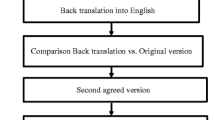Abstract
Purpose
To translate and culturally adapt the Foot and Ankle Ability Measure (FAAM) into Turkish and assess the psychometric properties of the translated version.
Methods
The FAAM was translated into Turkish according to Beaton’s recommendations and it is called FAAM-T. Ninety-eight patients (39 males, mean ± SD age 35.0 ± 14.0 years; range 16–71 years) with different foot and ankle complaints were included, and the score was completed twice by each participant after 7 days of the first assessment to assess test–retest reliability based on the inter-rater correlation coefficient, whereas Cronbach’s alpha evaluated internal consistency. External validity was evaluated with correlations between the FAAM-T, Foot Function Index (FFI) and Short Form-36 (SF-36). The distribution of floor and ceiling effects was determined.
Results
The test–retest reliability was 0.90 for both FAAM-T subscales. Cronbach’s alpha coefficient was 0.95 and 0.91 for FAAM-T activity of daily living (ADL) and FAAM-T Sport subscales, respectively. The FAAM-T ADL and Sport subscales demonstrated very good correlation with the FFI (r = 0.70 and 0.63, respectively). The FAAM-T ADL and Sport subscales had a high level of association with physical functioning and the physical component scale (r = 0.71, r = 0.70 and r = 0.51, r = 0.55, respectively; P = 0.001) of the SF-36. The weakest associations were found between the FAAM-T ADL, FAAM-T Sport subscales and the SF-36 the vitality (r = 0.27, P = 0.008 and r = 0.28, P = 0.01, respectively).
Conclusions
The study provides preliminary evidence that the FAAM-T is reliable, valid and responsive outcome measurement of patients with foot and ankle pathologies.

Similar content being viewed by others
References
Martin RL, Irrgang JJ (2007) A survey of self-reported outcome instruments for the foot and ankle. J Orthop Sports Phys Ther 37(2):72–84
Bennett PJ, Patterson C, Wearing S, Baglioni T (1998) Development and validation of a questionnaire designed to measure foot-health status. J Am Podiatr Med Assoc 88:419–428
Binkley JM, Stratford PW, Lott SA, Riddle DL (1999) The Lower Extremity Functional Scale (LEFS): scale development, measurement properties, and clinical application. North American Orthopaedic Rehabilitation Research Network. Phys Ther 79:371–383
Budiman-Mak E, Conrad KJ, Roach KE (1991) The Foot Function Index: a measure of foot pain and disability. J Clin Epidemiol 44:561–570
Martin RL, Burdett RG, Irrgang JJ (1999) Development of the Foot and Ankle Disability Index (FADI). J Orthop Sports Phys Ther 29:A32–A33
Martin RL, Irrgang JJ, Burdett RG, Conti SF, Van Swearingen JM (2005) Evidence of validity for the foot and ankle ability measure (FAAM). Foot Ankle Int 26:968–983
Karatepe AG, Günaydin R, Kaya T, Karlibaş U, Özbek G (2009) Validation of the Turkish version of the foot and ankle outcome score. Rheumatol Int 30:169–173
Nauck T, Lohrer H (2011) Translation, cross-cultural adaption and validation of the German version of the foot and ankle ability measure for patients with chronic ankle instability. Br J Sports Med 45:785–790
Borloz S, Crevoisier X, Deriaz O, Ballabeni P, Martin RL, Luthi F (2011) Evidence for validity and reliability of a French version of the FAAM. BMC Musculoskelet Disord 8(12):40
Mazaheri M, Salavati M, Negahban H, Sohani SM, Taghizadeh F, Feizi A, Karimi A, Parnianpour M (2010) Reliability and validity of the Persian version of foot and ankle ability measure (FAAM) to measure functional limitations in patients with foot and ankle disorders. Osteoarthr Cartil 18:755–759
Sartorio F, Vercelli S, Bravini E, Bargeri S, Moroso M, Plebani G, Ferriero G (2014) Foot and ankle ability measure: cross-cultural translation and validation of the Italian version of the ADL module (FAAM-I/ADL). Med Lav 105:357–365
Uematsu D, Suzuki H, Sasaki S, Nagano Y, Shinozuka N, Sunagawa N, Fukubayashi T (2015) Evidence of validity for the Japanese version of the foot and ankle ability measure. J Athl Train 50:65–70
Beaton DE, Bombardier C, Guillemin F, Ferraz MB (2000) Guidelines for the process of cross-cultural adaptation of self-report measures. Spine (Phila Pa 1976) 25:3186–3191
Ware JE, Sherbourne CD (1992) The MOS 36-Item Short-Form Health Survey (SF-36). I. Conceptual framework and item selection. Med Care 30:473–483
Koçyiğit H, Aydemir Ö, Fişek G, Ölmez N, Memiş A (1999) Reliability and validity of Turkish version of Short Form 36: a study of patients with rheumatoid disorder. Drug Ther 12:102–106
Yalıman ŞE, Eskiyurt N, Budiman-Mak E (2014) Turkish translation and adaptation of foot function index in patients with plantar fasciitis. Turk J Phys Med Rehab 60:212–222
Terwee CB, Bot SD, de Boer MR (2007) Quality criteria were proposed for measurement properties of health status questionnaires. J Clin Epidemiol 60:34–42
de Vet HC, Terwee CB, Bouter LM (2003) Current challenges in clinimetrics. J Clin Epidemiol 56:1137–1141
Nunnally JC, Bernstein IH (1994) Psychometric theory, 3rd edn. McGraw-Hill, New York
Kane RL (1997) Outcome measures. In: Understanding health care outcomes research. Aspen Publishers, Gaithersburg, pp 17–18
Gagliese L, Weizblit N, Ellis W, Chan VW (2005) The measurement of postoperative pain: a comparison of intensity scales in younger and older surgical patients. Pain 117:412–420
Weel H, Zwiers R, Azim D, Sierevelt IN, Haverkamp D, van Dijk CN, Kerkhoffs GM (2014) Validity and reliability of a Dutch version of the foot and ankle ability measure. Knee Surg Sports Traumatol Arthrosc 24(4):1348–1354
Author information
Authors and Affiliations
Corresponding author
Ethics declarations
Ethical standard
All procedures performed in studies involving human participants were in accordance with the ethical standards of the institutional and/or national research committee and with the 1964 Helsinki Declaration and its later amendments or comparable ethical standards.
Conflict of interest
No benefits in any form have been or will be received from a commercial party related directly or indirectly to the subject of this manuscript.
Rights and permissions
About this article
Cite this article
Çelik, D., Malkoç, M. & Martin, R. Evidence for reliability, validity and responsiveness of Turkish Foot and Ankle Ability Measure (FAAM). Rheumatol Int 36, 1469–1476 (2016). https://doi.org/10.1007/s00296-016-3485-4
Received:
Accepted:
Published:
Issue Date:
DOI: https://doi.org/10.1007/s00296-016-3485-4




